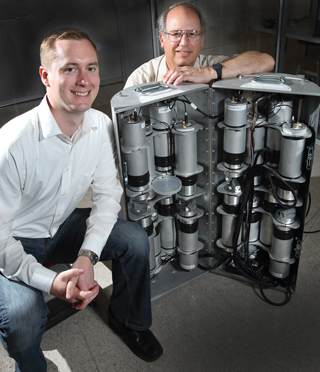
A nuclear device has been hidden in a high-rise building in a major metropolitan area. Emergency responders have intelligence that narrows the location to a single city block, but it isn’t safe to do a door-to-door search. Can responders identify the exact location of the device in a reasonable time period without the adversaries realizing that a search is being conducted?
The answer is a definite yes. Last spring, Sandia’s mobile imager of neutrons for emergency responders (MINER) system did just that at an emergency response exercise in downtown Chicago.
“The system performed exactly as we expected,” says John Goldsmith (8127). “With an unshielded source, we pinpointed the location within 30 minutes. With more shielding, it took a couple of hours.”
MINER, a project funded by DOE/NNSA, is a portable version of the Neutron Scatter Camera (see the April 10, 2009 issue of Sandia Lab News), which detects fast neutrons that emanate from special nuclear material to localize the source, even at significant standoff distances and through shielding. The original neutron scatter camera was quite large, standing about 5 feet tall and requiring a power source to operate.
MINER consists of 16 proton-rich liquid scintillator cells arranged inside a large cylinder. The scatter aspect comes into play as neutrons travel through the scintillator cells and bounce off protons like billiard balls. Those interactions between the different detector cells enable the instrument to determine the direction of the radioactive source that emitted the neutron.
Observing ‘hot spots’
As a neutron scatter camera, MINER has several advantages over other types of detectors, including the device’s effectiveness at discriminating uniform background radiation and imaging the spectrum of the neutrons.
“Simple neutron counters are unable to distinguish a threat source from an elevated neutron background. However, an imager such as MINER can do this by observing a ‘hot spot’ against the neutron background,” says John. “In addition, MINER’s ability to measure the neutron spectrum enables it to distinguish plutonium, a threat source, from AmBe [americium-beryllium, the most common commercial source of neutrons], which is not a threat source. Among imaging approaches, this capability is unique to MINER.”
MINER is about 3 feet high, weighs about 90 pounds, can be set up and taken down in about 10 minutes, and most importantly, can operate on battery power. “Since MINER doesn’t need to be tethered to a power source, it gives a lot of options to emergency responders,” says John.
The Chicago field test focused on neutron detectors, so MINER was one of three neutron imagers along with several neutron counters. The field test wasn’t a competition, says John, but a test of each detector’s capabilities.
“There are tradeoffs with every kind of detector. If you are trying to localize a source, a backpack detector might be the fastest, but there are scenarios in which walking around is not possible,” says John.
One of MINER’s strengths is its ability to provide omni-directional (4π) imaging. “Other imaging detectors have a very fixed field of view, so they look at a specific spot,” says Mark Gerling (8127). “MINER images a full 4π steradians, so all the way around and up and down. We imaged part of one side of an entire high-rise building at once and localized the source to a specific room. It’s extremely effective in this situation.”
MINER is also a two-for-one detector. The system was designed to optimize its performance for neutron imaging and spectroscopy, but its proton-rich liquid scintillators can also capture gamma rays. While not the most efficient or effective gamma ray detector, MINER’s design makes it suitable for several unusual applications.
“To use it as a neutron scatter camera, MINER is closed. But if we open it up, we can position it near a radiation source and gather additional information about that source. This could be very useful in determining how to handle an object that is emitting radiation.”
Future work on MINER includes developing a quantitative metric for characterizing detection significance, investigation of a neutron multiplication measurement capability, and potential participation in an at-sea maritime search scenario.